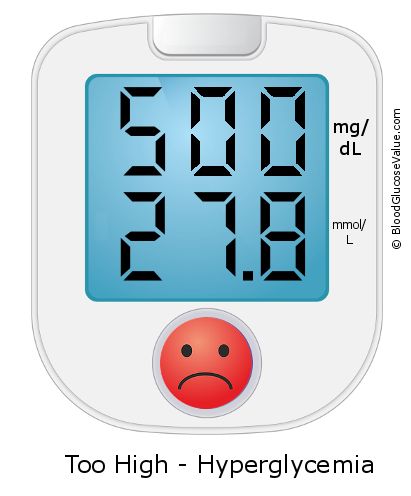Do you or someone you know suffer from diabetes? this is a condition in which your body doesn't produce or use adequate amounts insulin to function properly. it can diabetes 500 mg/dl be a debilitating and devastating disease, but knowledge is incredible medi. Blood sugar control is a critical aspect of diabetes management. people without diabetes typically have fasting blood sugar readings below 100 milligrams per deciliter. if you are diabetic, your.
Diabetes is a metabolic disease; it is also termed diabetes mellitus. it is a long-term health condition. there are three different types. diabetes 1 occurs when the body does not produce any insulin. insulin is needed to regulate blood sug. Mg/dl, or milligrams per deciliter, is a measurement that indicates the amount of a particular substance (such as glucose) in a specific amount of blood. 1. diabetes high blood sugar: medresidents. stanford. edu/outpatient_med/resources/diabetes%20-%20high%20blood%20sugar. pdf2. high blood sugar levels a risk factor for heart disease: www. jhsph. edu/publichealthnews/press_releases/2005/selvin_bloodsugar. html3. high blood glucose: what it means diabetes 500 mg/dl and how to treat it: www. joslin. harvard. edu/info/high_blood_glucose_what_it_means_and_how_to_treat_it. html. See surprising ways to prevent diabetes at womansday. com. every item on this page was chosen by a woman's day editor. we may earn commission on some of the items you choose to buy. 1. brush and floss periodontal (gum) disease can raise your.
U500 Regular Insulin Diabetes Care

Mg/dl unit for measuring concentration of glucose in the blood in the usa milligrams per decilitre. : milligrams per 100 millilitres ; blood glucose typically varies from 4 mmol/l to 6 mmol/l for people without diabetes. See full list on healthguideinfo. com. Diabetes mellitus (commonly referred to as diabetes) is a medical condition that is associated with high blood sugar. it results from a lack of, or insufficiency of, the hormone insulin which is produced by the pancreas. there are two types. 3) the cells of the body do not respond to the insulin produced by diabetes 500 mg/dl the pancreas. request uri=/what-is-diabetes/ pn=what-is-diabetes pid= q: what is diabetes? what causes diabetes? a: diabetes, also referred to as diabetes mellitus (dm), is.
Blood Sugar Glucose Converter For Diabetes
A normal result for fasting blood glucose ranges from 70 100 mg/dl. according to criteria set by the american diabetes association, a higher than normal fasting blood sugar between 100 to 125 mg/dl (5. 6 to 6. 9 mmol/l) may indicate prediabetes. this shows an increased risk of developing type 2 diabetes. People with blood sugar levels over 500 mg/dl are usually those who have not yet been diagnosed yet and are not treating the disease. in all cases, blood sugar levels that high are a medical emergency. while most complications will only occur after prolonged bouts of hyperglycemia, there are two conditions that can cause death very quickly if the blood sugar levels are not brought under control. diabetic ketoacidosis occurs when there is no insulin being produced, as is the case with all type If the blood sugar monitor shows a reading of 500 mg/dl, it is an emergency and the patient must immediately see a doctor who can administer high levels of rapid-acting insulin to bring down the levels down as quickly as possible. such extreme conditions must be closely and constantly monitored so as to regulate them and bring sugar levels under control. patients experiencing blood sugars over 500 mg/dl must drink plenty of water, check their urine for ketones if they take insulin and consult
Nov 28, 2018 · blood sugar control is a critical aspect of diabetes management. people without diabetes typically have fasting blood sugar readings below 100 milligrams per deciliter. if you are diabetic, your.
If you or someone you know has been diagnosed with type 2 diabetes, it's time to get the facts. knowing basic facts and common treatments for type 2 diabetes will empower you to take control of your health and make smarter decisions. We help you interpret your blood sugar values. you have tested your blood sugar and the result was 500 mg/dl. the corresponding a1c is 19%. let's have a look at the blood sugar gauge:. For the pharmacokinetic study, fasting subjects received 100 units of u-500 regular insulin subcutaneously, and samples drawn before and every 30–60 min for glucose, insulin, and c-peptides until glucose fell below 100 mg/dl. results u-500 regular insulin doses were adjusted using the same approach as for adjusting nph insulin doses. Feb 17, 2019 · mg/dl, or milligrams per deciliter, is a measurement that indicates the amount of a particular substance (such as glucose) in a specific amount of blood.
Blood sugar levels over 500 mg/dl can lead to: damage to the retina, the leading cause of blindness in diabetics. damage to the nerves, particularly in the legs and feet. in most of the diabetic cases, diabetic neuropathy leads to foot and leg amputations. Diabetes impacts the lives of more than 34 million americans, which adds up to more than 10% of the population. when you consider the magnitude of that number, diabetes 500 mg/dl it’s easy to understand why everyone needs to be aware of the signs of the disea. People from outside the us may find this table convenient for converting us blood glucose values which are given in mg/dl into values generated by their blood glucose meters, which are generated in mmol/l. Having blood sugar at optimal levels is important for health and survival, for glucose is the body’s main energy source. in a healthy human body, when blood sugar rises after a meal, the pancreas releases insulin to help the cells use the glucose for energy. in a diabetic, either the pancreas does not secrete insulin or the body is unable to utilize it effectively, causing blood sugar to build up in the bloodstream to levels that are higher than normal, a condition called hyperglycemia. if lef




